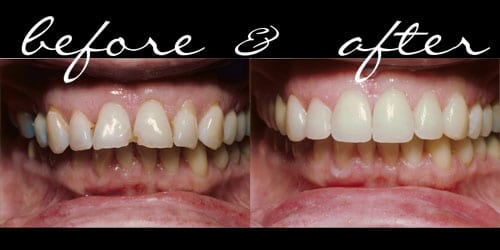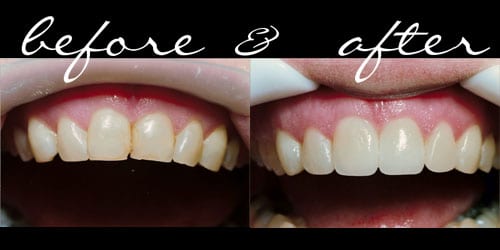Many people are unhappy with the way that their teeth look. There are now many cosmetic treatments and materials that can improve the appearance of your teeth.
Bonding, uses a composite resin (a plastic material) that is color matched to a patient’s teeth to correct dental problems. It is one of the most common cosmetic treatments and is safe on children to adults. Reasons for bonding include: badly fractured or chipped teeth; cavities, small teeth and widely spaced, malformed, or badly stained teeth.
Bonding Before and After


The Dental Bonding Procedure
To start, a mild etching solution is applied to the enamel of the tooth being treated. The etching solution causes the tooth enamel to become slightly rough, which will allow other materials to bond to the tooth. Next, the tooth is painted with resin (a liquid plastic material). The durable resin adheres to the etched surface, where it is held firmly.
At this stage, the dentist may choose to either apply a composite resin, or bond acrylic or porcelain veneers to the teeth depending on the problem being treated.
The composite resin is a thicker plastic material that is used to form, rebuild, or replace parts of a tooth. After the composite resin has been shaped, it is hardened by either a chemical process or by exposure to a special light. The surface of the composite resin will then be polished.
The acrylic or porcelain veneers use the same resin materials as the bonding agent and are bonded to the front surfaces of the teeth.
Advantages and Limitations of Bonding
There are many advantages to bonding. Bonding can improve the appearance of teeth without drilling or anesthesia. Teeth that have been bonded generally require a shorter treatment period and may cost less than crowns.
Bonding also has limitations. Bonding is used primarily as a way to improve the cosmetic appearance of the front teeth. Teeth that have been bonded are not strong enough to withstand the pressure that is exerted on the back teeth or any of the chewing surfaces of the teeth.
Bonded teeth typically have an average life of 3-5 years which is somewhat shorter than the average life of a crown. Composite resin materials also have a tendency to stain rather easily, especially if the person smokes, drinks coffee or tea, or eats certain types of foods. Over time, bonded teeth can appear more discolored than regular teeth.
Veneers offer a more permanent solution to bonding. Veneers allow for minimal removal of tooth structure. With veneers, teeth can be made to the ideal shape, size, and color.
In Summary…
There are several cosmetic treatments that improve the appearance of your teeth and smile. A dentist will be able to recommend a particular treatment after a thorough examination of your teeth and considering your individual needs.
If you are unhappy with the way that your teeth look, check with a dentist about the many different techniques that can be used in cosmetic dentistry. Many people, just like you, have taken this step, and have happier, more beautiful smiles to prove it.

